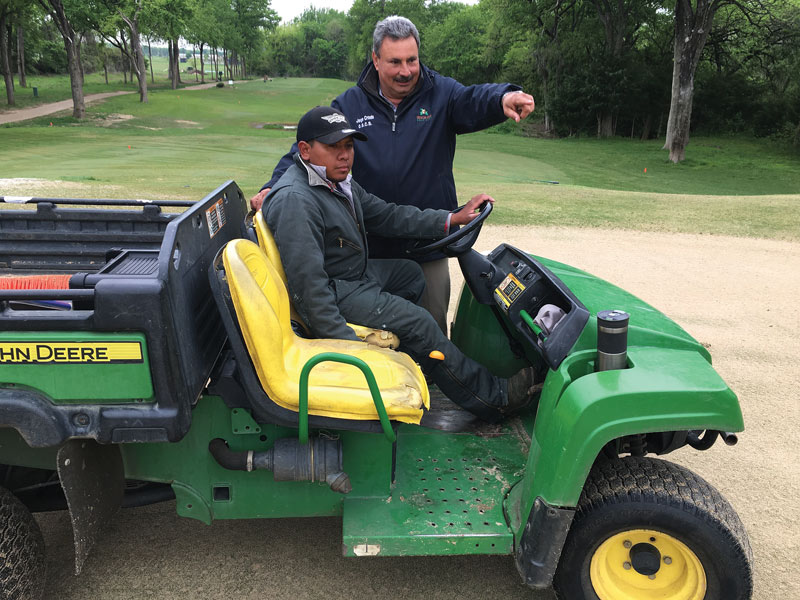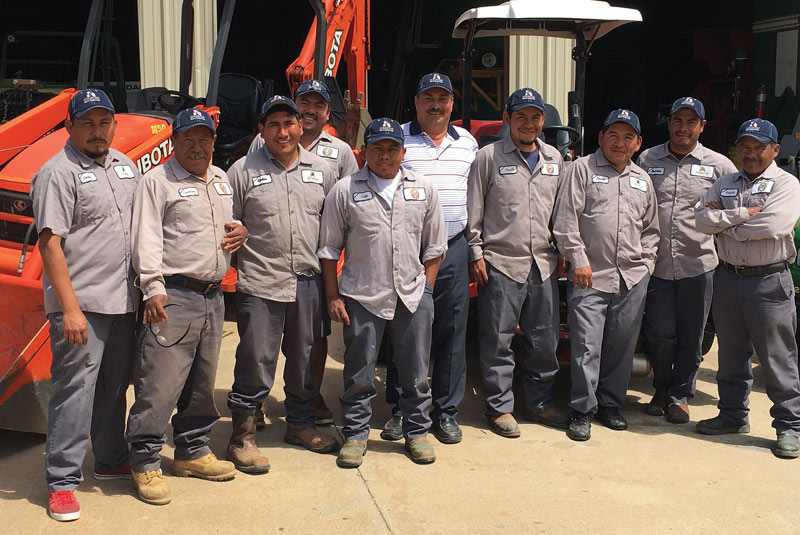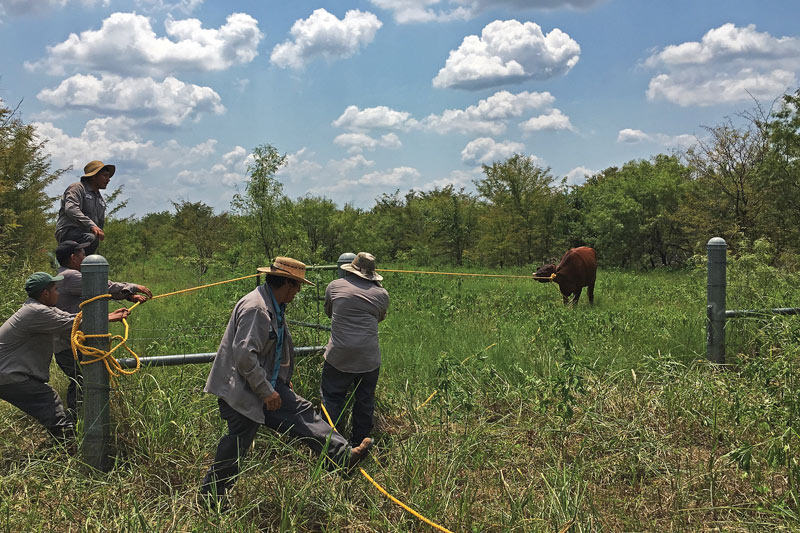
A ripple effect: The superintendent sets the workplace culture and can instill enthusiasm in team members, positively affecting the quality of their work, the golf facility and, ultimately, the customer experience. Photos courtesy of Jorge Croda
The United States is home to more golf courses than any other country, and such competition means superintendents must be mindful of building and keeping relationships with golfers by providing a unique, high-quality, memorable playing experience. How do we achieve this? Much goes into it, and day-to-day tasks such as mowing and managing turf treatments are just a drop in the bucket of what superintendents do and what’s required for success. One component of success that’s sometimes overlooked is passion — having a passion for what we do, and knowing how to turn that passion into tangible results.
Gandhi once said, “The difference between what we do and what we are capable of doing would suffice to solve most of the world’s problems.” Passion is what pushes us over the threshold from what we do because we have to and what we do because we want to.
Passion can mean different things to different people. To me, golf is more than a game — it’s a passion and a lifestyle. Not a lifestyle in the sense of money, cars and extrinsic things, but a lifestyle in the sense of what I gain from applying the principles of the game and of maintaining its surfaces to other aspects of my life. Using my passion by approaching everything through the tenets of the game of golf — be respectful, follow the rules, consider the options, make the best choice for the situation, and have fun — has opened up a completely new world in terms of how I handle situations and what I’m able to achieve. My passion for golf informs both my life and my work.
Creativity, imagination and innovation are other hallmarks of a successful golf course superintendent, and these traits have a primary role in bringing passion into our work. As a superintendent, I do not strive to be the best; I strive to be different. Passion coupled with creativity gives one a “signature,” and because most of our work as turfgrass managers is done behind the scenes, this individuality gives us a way to demonstrate our unique worth. More important, though, passion and creativity allow us to adapt to and work in any circumstance, no matter how challenging. Tasks and projects that may have previously seemed impossible because of a lack of resources, space or manpower are within reach when we tap into our internal drive and resources.
What follows are some ideas and tips for nurturing your passion for your work and translating it into a well-run golf course operation and a superior golf experience for your customers.
1. Shift your perspective
When I tell people what I do for a living, two common responses are, “Oh, you have to get up so early,” and “Oh, you have to work outside every day.” Yes, I do get up early, but I get to see the sunrise. Yes, I work out in the elements every day, but I get to be a steward of the environment. As a superintendent, I feel lucky that I get to spend each day out in a beautiful, natural setting.

The maintenance crew at Southern Oaks Golf & Tennis Club in Burleson, Texas (from left): Hugo, Francisco, Juan Carlos, Alejandro, Diego, Jorge, Roberto G., Fausto, Roberto O. and Roberto C.
Life is all about perspective. Negatives and positives exist in every situation, every day. What we look for, we will find. We can choose to focus on the negative and be unhappy, or we can choose to focus on the positive to cultivate contentment. In those moments when we’re taking a step back from our lives to assess where we are and where we want to be, a shift in perspective can be a valuable tool to keep us motivated to be our personal best. You have the power to shape how you think, and as was true for me in looking at life through the principles of golf, having a different mindset can give rise to different, improved outcomes.
Day-to-day tasks such as checking the height and speed of greens or performing routine repairs on machinery can seem repetitive and mundane. But if we adjust our perspective to view these duties through the lens of someone who feels fortunate to have a job that requires them to be on a golf course every day, we might realize that those daily, ordinary tasks allow us to experience amazing things. We get to smell the aromas of the flowers and fresh-cut grass; listen to the singing birds; watch the flight of hawks and butterflies and other insects; breathe fresh air; see the joy on a golfer’s face when they make that perfect shot; and hear the appreciation in a golfer’s voice when they enjoy a particular hole or course feature. All the while, we get to work in a dynamic, rewarding setting, be part of a cutting-edge industry, use our imaginations, and serve in the important role of environmental steward.
2. Set a new workplace culture
Other than personal fulfillment, are there other advantages to being able to shift our perspective? Can this benefit our golf operations? In my opinion, yes, and one way is through increased employee and customer satisfaction.
I look at this as a ripple effect. Our own passion leads to personal satisfaction, which allows us to approach situations with a clearer mind and be more positive with our team members. Instead of expecting our employees to be happy just “because they have a job,” we can see them as the assets they are — as individuals with much to contribute to the mission and vision of the golf facility. Treating employees well, playing to their strengths and showing them appreciation fosters employee satisfaction, ownership and, ideally, even their own sense of passion for their work. This in turn is reflected in their work output as well as the consideration they show to customers.

An unexpected visitor: The Southern Oaks crew collaborates to wrangle a wandering cow that broke through the fence bordering a neighboring property.
Customer service is essential to any successful business, and the main component of customer service is the person who’s providing the service. It’s a simple yet profound truth that happy employees produce happy customers. In today’s competitive market, it is imperative to create a workplace culture that honors this fact. A management style that prioritizes employee happiness can mean a variety of things — taking concerns and suggestions to heart, being responsive and flexible, encouraging ownership of and pride in work, and recognizing accomplishments.
We must focus on being leaders and not “bosses.” As leaders, we should strive to develop other leaders who have the knowledge, skills and willingness to step up when a challenging situation may arise. The greatest feather in any leader’s cap is a strong team of individuals who are ready, willing and able to take the lead within the department. If our employees are well taken care of, they are going to positively affect customers and do their part to make sure customers are well taken care of. Satisfied guests equate to repeat business, and repeat business equates to increased revenue — the ultimate goal of any business.
3. Connect with peers, customers
A perk of being a golf course superintendent is the ample opportunities available to network with peers who share our passion. Each of us is a part of a diverse group of professionals throughout not just the United States, but the world, who have a common interest in and vast wealth of knowledge about golf course management. Technology allows us the luxury of engaging with each other — across town and across the planet — to impart insight and ideas in ways that were previously unimaginable. Through this information sharing, I believe we better ensure the success of not just our individual golf courses, but the golf industry as a whole.
Such camaraderie has expanded my passion for the work I do, and I think this remarkable aspect of our industry needs to be brought more to the forefront. Individually, we don’t have all the solutions, but collectively, we have an overwhelming amount of knowledge. I’ve found that I lean on fellow superintendents for help predicting potential challenges and complications and the impact these may have on my course and customers. As superintendents, we need to have tremendous foresight, and the wisdom of my colleagues has been extremely beneficial to me in this capacity, among many others.

The 10th tee at Southern Oaks, an 18-hole layout about 12 miles south of Fort Worth. It was recently named among the top public courses in the Dallas-Fort Worth metroplex by AvidGolfer magazine.
Closer to home, connecting with our own clientele and gaining their trust is another ace in the hole. Consider inviting your guests to play a round with you so you can directly hear their feedback and address it in real time. This may seem like a small gesture, but these types of actions establish relationships that can be a boon to both parties. Here at Southern Oaks Golf & Tennis Club in Burleson, Texas, taking the time to build relationships with customers has created trust as well as a constant, open line of communication. Many customers are comfortable coming to me with questions, concerns and compliments, and anytime they have kudos, I remind them they can also pass them along to anyone on the maintenance team.
Recently, some of the members suggested they plan a lunch for the maintenance department to show their appreciation for the crew’s hard work and the excellent course that is the result of it. The lunch was a huge success, with more than 25 members and the entire maintenance crew attending. The staff was incredibly grateful for and encouraged by the gesture, and I think it took the already-growing trust and relationships to a new level, which will mean only good things for the maintenance department, the golf course and the customers we serve.
Jorge Croda, CGCS, is the golf course superintendent at Southern Oaks Golf & Tennis Club in Burleson, Texas, and an 11-year member of GCSAA. He is active in GCSAA and the North Texas GCSA, is a certified life skills coach with The First Tee, and travels the world sharing his knowledge of and passion for golf, leadership and team building. He lives in Fort Worth, Texas, with his wife, Linda, and has three children, Jimena, Jorge and Maria.